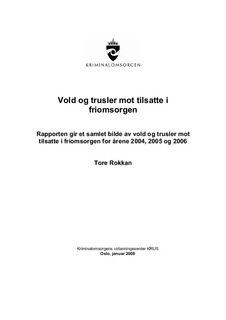| dc.description.abstract | Violence and threats against staff at the probation service has never been the main focus in the
Correctional Service in Norway. Nevertheless, many employees report that they have had
experiences that have been unpleasant or hard to handle. In several offices, this has lead to
different kinds of actions; physical and statical measures like alarm systems and closed doors,
organisational measures like meeting points and communication lines, and dynamic measures
like communication and cooperation solving the tasks.
The probation offices solve these tasks in different ways. One of our hypotheses in the study
was to identify a “traditional” versus “modern” organisation culture. We did not succeed in
that. The relatively small number of reported incidences did not give us any clear direction or
strategy that seemed better in coping with violence and threats against staff.
Included in this study are the findings from a broad survey about Safety and Security in the
Probation Service (SIFO) as a part of a larger program for Safety and Security in the
Corretional Service (SIK). This survey also documents the differences in culture, methods and
practical solutions in the daily work. Some offices more often include prison, the social
municipality and other service providers in their work. This corresponds to the type of
offenders that uses the office, their crime, type of sentence and so on.
For the period from 2003 to 2007 the total number of reported incidences was 39. In seven
incidences these were psychical or social violence. In the SIFO survey three quarters
responded that their colleges had been threatened. Only one quarter had been threatened
themselves.
The most difficult violence situations are those that not make a scare. This is incidences that
are not seen or recognised by co-workers and leaders. The symbolic violence (verbal ore nonverbal
symbolic violence) is the dominating of the violence types. In a parallel study
(Hammerlin & Rokkan 2008 b) we see that the symbolic, psychical and social violence also
are those that are causing most anxiety for the employee involved. The studies also show
how a small group of offenders was responsible for a large number of incidences. They also
show that some officers were exposed for a larger numbers of situations than others.
This combination of factors is calling for the awareness of violence and threats towards staff
in the probation services, especially because of the relatively low number of reported cases. It
is easy to privatise the situations, especially those that do not make scares. The important
challenge in this is to create cultures that include every employee and makes the individual
incidents a collective responsibility. | en_US |
